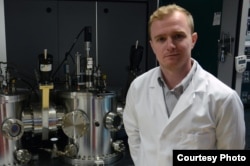Scientists in England report the development of a new solar cell that minimizes environmental risks in the manufacturing process by using an element used in bath salts.
Many of the solar panels you see on roof tops use special materials called semiconductors such as silicon to generate electricity. However, silicon is not especially good at absorbing sunlight, says Jon Major, physics professor at the University of Liverpool in England.
“To absorb a useful amount of sunlight with silicon we would need to use around 200 micrometers of material." Major said. "For absorbers such as cadmium telluride, we need to use only 1 percent of the same material.”
Which is why cadmium telluride is now firmly established as the market standard for making the next generation of solar cells. It results in more flexible panels and dramatically outperforms silicon, with one major drawback.
“The problem is cadmium telluride itself is a highly toxic compound," Major said. "It’s been linked to genetic defect, and if it gets into the water supply, it can poison fish for generations.”
That’s why Major and his colleagues started looking for alternatives to cadmium chloride, the crystalline compound used in the solar cell manufacturing process. As they report in Nature, they found that magnesium chloride is an efficient, low cost and harmless substitute.
“It is simply recovered from sea water and it is currently used in a number of applications such as salt roads in icy conditions," Major said. "You can buy it as a health supplement or mineral bath soak. It’s also used as coagulate for the production of tofu.”
Major has filed a patent on the manufacturing process using magnesium chloride, but says it will take time for the industry to adopt it.
“The only reason we can really say why no one has these is because cadmium chloride works really well, and if it isn’t broke, then no one has bothered to fix it," he said. "So, I mean for myself, I’ve been working with cadmium telluride solar cells for about 10 years now and cadmium chloride has always been viewed as the process. That’s the one you use. That’s how you make solar cells and no one has really varied from that.”
Major will continue to refine the process for its potential in the solar industry.
“The work is a good example of the important role academic research can play in industrially established technologies,” he said.










